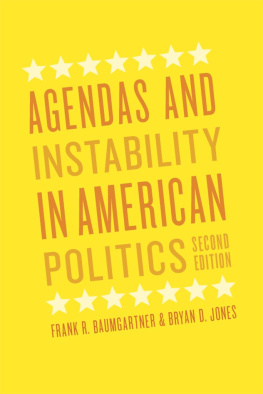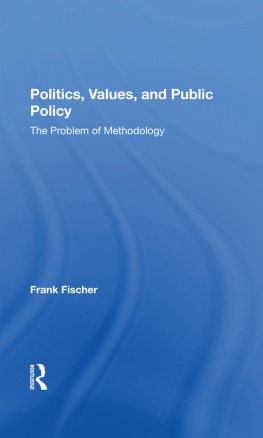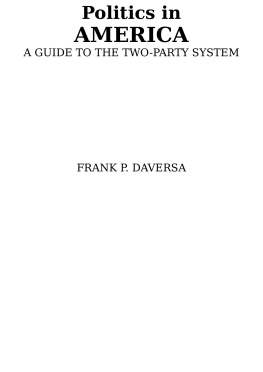The Politics of Information
The Politics of Information
Problem Definition and the Course of Public Policy in America
Frank R. Baumgartner and Bryan D. Jones
The University of Chicago Press
Chicago and London
F RANK R . B AUMGARTNER is the Richard J. Richardson Distinguished Professor of Political Science at the University of North Carolina at Chapel Hill. B RYAN D . J ONES is the J. J. Jake Pickle Regents Chair in Congressional Studies in the Department of Government at the University of Texas at Austin. Together, they are the authors of several books, including Agendas and Instability in American Politics, also published by the University of Chicago Press.
The University of Chicago Press, Chicago 60637
The University of Chicago Press, Ltd., London
2015 by The University of Chicago
All rights reserved. Published 2015.
Printed in the United States of America
24 23 22 21 20 19 18 17 16 15 1 2 3 4 5
ISBN-13: 978-0-226-19809-5 (cloth)
ISBN-13: 978-0-226-19812-5 (paper)
ISBN-13: 978-0-226-19826-2 (e-book)
DOI: 10.7208/chicago/9780226198262.001.0001
Library of Congress Cataloging-in-Publication Data
Baumgartner, Frank R., 1958 author.
The politics of information : problem definition and the course of public policy in America / Frank R. Baumgartner and Bryan D. Jones.
pages cm
Includes bibliographical references and index.
ISBN 978-0-226-19809-5 (cloth : alkaline paper) ISBN 978-0-226-19812-5 (paperback : alkaline paper) ISBN 978-0-226-19826-2 (e-book) 1. Federal governmentInformation resources managementUnited States. 2. United StatesPolitics and government19451989. 3. United StatesPolitics and government1989 4. Policy sciencesUnited States. I. Jones, Bryan D., author. II. Title.
JK271.B36 2015
352.3'80973dc23
2014014262

This paper meets the requirements of ANSI/NISO Z39.48-1992 (Permanence of Paper).
We dedicate this book to our studentsfrom today, from yesterday, and from quite some time ago!
Contents
This book follows a research path that we began in 1987 and which has led us into a number of studies of many types. We began with a suspicion that political science had overestimated the weight of inertia and stability in the policy process and, by studying a number of individual policy issues over time, were able to develop a theory of punctuated equilibrium in order to explain not only the obvious stability that characterizes most issues most of the time but also the periods of abrupt change. Tracing the route of individual policy histories over time remains the single most approachable and common path to theory building in this area.
Our discovery that we could develop quantitative indicators of the agenda status of an issue, as well as how it was framed in the media and government discussion, led to a proposal to the National Science Foundation to create comprehensive indicators of U.S. federal government activities from approximately 1947 to the present. The result of that and subsequent grants has been the creation of the Policy Agendas Project (http://www.policyagendas.org). This resource now includes over 1 million observations, allowing anyone with an Internet connection to analyze trends in U.S. federal policy activities, including congressional hearings, laws, presidential speeches, and a growing collection of other indicators from 1947 to current times. The large datasets available allow us to investigate the patterns of stability and change that characterize government in all domains. It would not have been possible to create this resource without the continued efforts of dozens of collaborators and students. It has also led to some unorthodox methodological approaches. Indeed, since our first focus on tracing the path of individual policies over time, with the data resources that the agendas project makes available, we have gone well beyond this approach. While stochastic modeling does not allow us to understand much about any particular policy domains, it allows new insights into the general patterns of change that characterize them all. We are convinced that a combination of close study of individual policy issues and broad overviews of the general patterns of attention in government will lead to the greatest number of insights; we know that no single approach alone can be as useful as a combination of approaches.
Some of the most exciting projects we have been involved in over the past years have been associated with a network of colleagues, collaborators, and, now, friends who have replicated the U.S.-based Policy Agendas Project across many different political systems (see http://www.comparativeagendas.info). Studies we have done with them, and others they have done without us, relating to budgets, legislative activities, executive actions, and the impact of elections on policy priorities have reassured us that our U.S.-based findings are far from unique. Indeed, to the extent that much of what we describe here is due to general characteristics of human cognitive processes, our approach has the potential to be universalistic, applicable, we suspect, in any large and complex organization (whether in government or in the private sector, though to our knowledge these ideas have not been tested in nongovernmental settings). It has been a true intellectual pleasure to work with others gathering evidence and collectively puzzling over the best ways to answer questions about democratic governance, human attention, and policy change in a manner consistent with what the data show. This has led us to refine some of the ideas with which we started over twenty-five years ago and to develop new ones.
The organization and prioritization of information has become increasingly central to our studies. Governments are complex adaptive organizations, but to what are they adapting? We made the case in The Politics of Attention that processing information within policy-making structures invariably leads to a disjoint pattern of policy outputs, because attention implies inattention, and inattention to important developments in the environment can build up and cause a scramble to address them. We used the phrase error accumulation to describe this process: information that is temporarily ignored because of information overload or institutional resistance eventually accumulates and surpasses a threshold where it can no longer be ignored, leading to a rapid catch-up that often leads to a policy punctuation.
Any study of the role of information in policy making should, it seemed to us, rely on information. Or maybe our interest in information came from our insistence that we give pride of place to observation and measurement in analyzing government. Cause and effect are easily switched in the human mind. We have spent over twenty-five years focused on developing new indicators of what the government does. In this book we continue our focus on observation. Certain patterns jump out from any analysis of the huge range of behaviors and trends we review here. But just as we note that political leaders often trade off the scope of their jurisdictions for an illusion of control, we can make the same argument regarding our own profession. We certainly do not believe we have given the final word on the developments we explore here. We have taken the observations as they fall out, and we have not limited our purview only to a narrow slice of the political world. By taking on such a broad set of observations, the patterns we observe as well as the explanations we develop for them will be very general. It will fall to us in other projects and to others in the future to delve into some of these arguments in greater detail, exploring how they manifest themselves in detail during the day-to-day or year-to-year functioning of individual policy domains, agencies, and policy communities, and to understand the role of individual leaders in pushing the system in this or that direction.
 This paper meets the requirements of ANSI/NISO Z39.48-1992 (Permanence of Paper).
This paper meets the requirements of ANSI/NISO Z39.48-1992 (Permanence of Paper).











